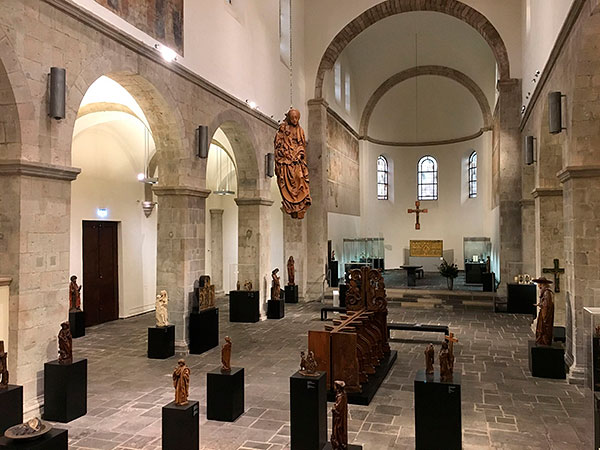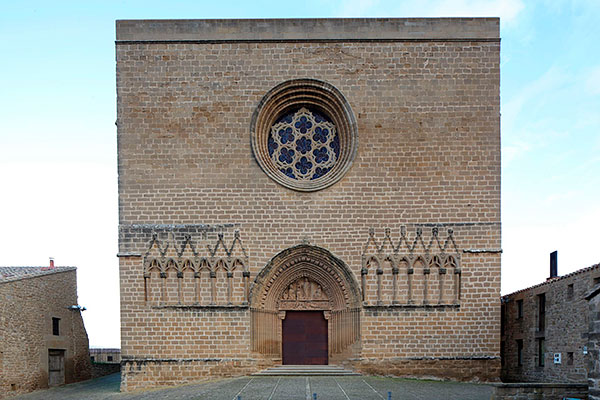31 May
lecture
A round trip between museums and churches
Justin Kroesen
University of Bergen (Norway)
The study of medieval art necessarily moves between museums and churches, which are the two frameworks where today we find the vast majority of works. The relationship between these two historical quarries is fascinating, since on the one hand they are very different and on the other they are parallel. Due to the vicissitudes of history, many pieces have left their original context and have entered museums, where today we contemplate them as works of art. But this is only the last stage in their long biographies. To understand medieval art we have to go back to the context where 99% of the works that have come down to us were integrated: the church. It is there where the works found their sense and meaning, in the functional framework of liturgy and devotion.

In the Schnütgen Museum in Cologne (Germany), the two main frames of medieval art coincide. It is a Romanesque church converted into a museum of medieval art. Photo: Justin Kroesen.
Churches have always been public, common spaces, which were open and accessible to the whole community, because they belonged to that same community; they were its common space. Everyone entered the church - men and women, old and young, rich and poor - unlike, for example, in castles and palaces. For most people in the Age average, the local church would undoubtedly be the largest, best built and most decorated building they would enter in their lifetime. It was in the church that society celebrated its central events, the 'hinge moments' of life, such as baptisms, marriages and funerals. Therefore, we can say that the medieval church was where people lived and died.
All these meanings and experiences are reflected in artistic expressions painted on the walls and sculpted on the altars. We can affirm that medieval churches, their arts and rituals are our most direct link to the past. The interiors of churches and their iconography inform us of the lives of our ancestors through the organization of space, images, objects and texts. Altars and tombs, sculptures, pillars and grilles and their imagery tell us about their living conditions, their beliefs, their hopes and anxieties, their vision of life and death, and their moral concepts. In addition, churches preserve a large part of our collective report in their archives.
In 1878, the German writer Theodor Fontane, in his famous descriptions of his wanderings through the Duchy of Brandenburg(Wanderungen durch die Mark Brandenburg), called village churches "the only monuments that reflect our entirehistory" (italics in original), because they are charged with "the magic of historical continuity". That magic is the feeling we experience when we visit medieval churches, during the work countryside or while on vacation. It is here that several factors come together, such as the distance we have traveled to get there, the surrounding landscape, the weather, the light, the status of the church in the village, and the always fascinating aspect of the ancient walls.
In many towns and cities the churches are by far the oldest buildings. Although they are all different, virtually every medieval church throughout Europe follows the same basic structure, consisting of nave and chancel facing east, with the high altar at the chancel. What we historians and art historians look for in these places is, among the commonality and distinctiveness of each church, a sense of authenticity. This is a difficult concept to define, but it is more than the naive romantic idea of the absence of any change. It is about training the eye to capture the genius loci, the local peculiarity, what this specific place has to tell us.

Each medieval church brings together something familiar, already known, and something peculiar, which is new; together they produce the genius loci. Artajona, Navarra. Photo: Justin Kroesen.
Medieval churches are places of deep, dense report . Their historical weight, in religious and cultural terms, means that they have not lost their significance today, regardless of whether we are believers or not. An important factor in the conservative strength of the churches is the slow, gradual -evolutionary rather than revolutionary- pace with which the changes came. Their construction used to be spread over several generations and the liturgy has followed much the same script for over a thousand years. Churches have always been relatively safe and protected spaces, controlled, directed towards the survival of the objects and documents they contain. This is an important aspect shared between museums and churches.
In fact, churches have always served as a sort of proto-museums to house and exhibit what the community considered most valuable and worth preserving, from miraculous sculptures to collections of relics, valuables, antiquities and curiosities of all kinds subject. In the 17th century, Canon framework Antonio Boldetti assembled a collection of ancient epigraphic material from the Roman catacombs in the atrium of the Basilica of Santa Maria in Trastevere in Rome. On the other hand, the member of the clergy and collector Francesco Bianchini established, around 1700, the first Ecclesiastical Museum in the Vatican to house Christian antiquities. Although the material displayed in both sites is the same, the former was visit as a church and the latter as a museum.

The atrium of the Basilica of Santa Maria in Trastevere in Rome acquired the character of a museum as early as the 17th century, when its walls were carpeted with spolia from the catacombs. Photo: Justin Kroesen.
Generally speaking, thanks to churches and museums today we can access the Age average, that fascinating period that sometimes seems so close but at the same time was so different from our time. While museums have rescued medieval works of art that were in danger of disappearing, in churches we can discover the original context that produced them and filled them with meaning. To do justice to the works and their biographies, museum technicians must try to understand the work of art for what it is: a religious object that became a museum object because of its artistic quality. To do this, it is not a matter of looking at the works with the eyes of the believer, but with the trained eye of the historian who knows both contexts.
It is to be hoped that more bridges will be built between museums and churches. In the great museums the transcendent, invisible aspect of medieval art does not usually receive much recognition. The 18th century Enlightenment that generated the modern museum understood this institution as primarily secular, secular. For the Enlightenment, religion was primarily a relic of the past and a sign of a less advanced culture. Even today, there is a complicated relationship between the museum and the religious content of the works of art it houses. In 2017, in the introduction to their book Religion in Museums, Crispin Paine and Brent Plate pointed out that in certain exhibition catalog texts and cartouches one can often sense a certain discomfort, especially when it comes to Christianity.
At the same time, nolens volens, museums have inherited part of the aura of sacredness that has traditionally surrounded the church. However, as Vincent Debiais of the EHESS/CNRS in Paris and Poitiers reminds us, the character of the sacred found in the church and in the museum is not the same. What has happened in the modern museum is a displacement of the religious content towards the figure of the artist and his talent. Instead of a cult of God and the saints, there has come a cult of human genius. It is almost a cliché to say that museums are the cathedrals of our contemporary society. But it is true that both remind the visitor that there is something in life that is greater than the individual human being. For many, the museum has replaced the church as the place to go in search of the transcendental.
For rapprochement between churches and museums, it is necessary that both better understand their role in the production, conservation and communication of heritage. That the Church today, for its part, be even more aware of its special role as heir to a great cultural bequest which is perhaps our greatest common treasure. That it not only feels that it owns the monuments and art it holds, but that it also values them for the whole of society, believers and non-believers alike. And that it understands that it is a great privilege to be able to continue using the oldest and most beautiful monuments that we preserve, which were erected in their day by the entire community, our ancestors.
The museum, on the other hand, would like to recognize even better the religious value of the medieval art it preserves. This means understanding the works of art from their own biographies: socialized in churches, surrounded by liturgical ritual and devotional gazes. The museum and the church can learn a lot from an open dialogue about this common heritage that both have under their guardianship. And so, we will all grow: churches will be recognized as 'the greatest museum in Spain', while museums will recover the role of public space that invites citizens to reflect on existential questions. In the words of Simon Jenkins, author of the successful book England's 1000 Best Churches (1999), in cultural heritage "it's not about having more, it's about being more".
